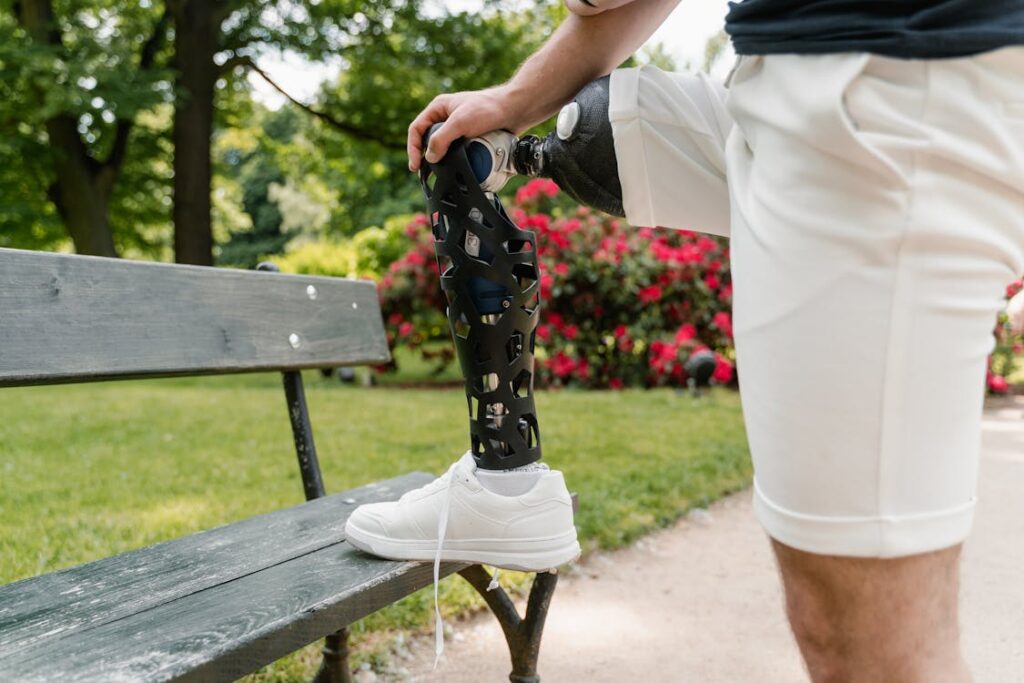Losing a limb changes your life. There’s no easy way to say it. But the moment you start to heal, both physically and emotionally, one question often comes up again and again—”When should I get my first prosthetic?” It may sound like a simple question, but it’s more personal and complex than people realize. The right timing can shape your recovery, mobility, and confidence in powerful ways.
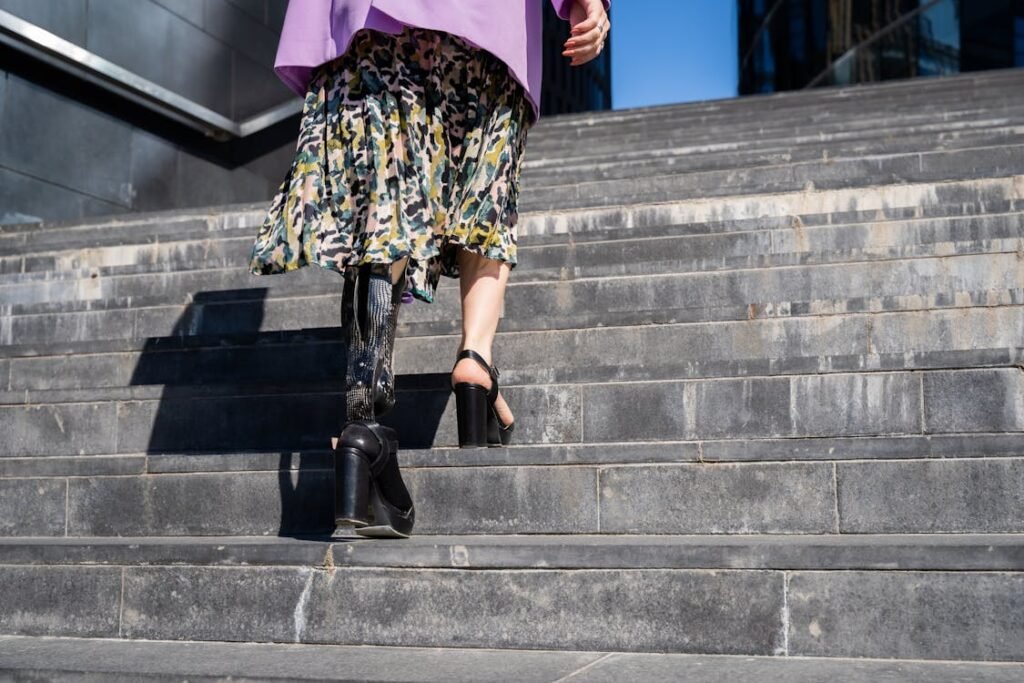
Step 1: Understanding What Happens Right After Surgery
The First Few Days Are About Healing
When someone goes through an amputation, the first priority is always healing. Right after surgery, the focus is on managing pain, avoiding infection, and making sure the wound closes properly. This is known as the post-operative phase.
During this time, your medical team will monitor how your body is responding. Are you healing well? Is there too much swelling? Are there signs of infection or blood flow issues? These details matter because they affect when and how you can start thinking about a prosthetic.
You won’t be ready for a permanent prosthetic right away, and that’s completely normal. The limb needs time to settle down. The swelling will reduce over several weeks. The tissues will start reshaping themselves. The stitches will heal. Only after this foundation is strong can you move forward.
But here’s something people often don’t realize: Even though you’re not getting your permanent prosthetic yet, this phase is where prosthetic preparation actually begins. Decisions are already forming. Your body is laying the groundwork.
Step 2: Meeting the Right Experts Early
Why a Prosthetist Should Be Part of the Process From the Start
One of the best things you can do early on is to connect with a prosthetist—a specialist who designs, fits, and adjusts prosthetic limbs. Many people wait until weeks or even months after surgery to meet one, but involving them earlier can make a huge difference.
A prosthetist can assess your limb, talk to your surgeon, and help you plan for what type of prosthetic would suit your body, lifestyle, and future goals. They’ll also watch how your limb is healing and changing. This helps them prepare the first temporary socket when the time is right.
Even if your body isn’t ready for a prosthetic yet, your mind might be. Meeting a prosthetist early gives you a clearer picture of the road ahead. You get to ask questions, set expectations, and feel like you’re part of the decision-making. That makes the whole process feel less scary.
Another reason early contact helps? The prosthetist gets to know your story—not just your measurements. That human connection builds trust, and that trust will matter when you take your first steps again.
Step 3: Recognizing When Your Limb Is Ready
The Signs Your Body Is Prepared
There’s no universal date when someone becomes “ready” for their first prosthetic. It depends on your health, the type of amputation, and how your body heals. But there are clear signs that professionals look for to decide when it’s safe to begin the fitting process.
The most important sign is wound closure. The surgical site must be completely healed—no open areas, no stitches left, and no fluid or infection. If there’s even a small wound that hasn’t closed properly, fitting a prosthesis too soon could lead to serious complications.
The second sign is controlled swelling. After amputation, the limb swells naturally. Over time, with compression and rest, the swelling should come down. When your limb looks more stable in size—day after day—it shows that it’s ready to hold a socket.
Another clue is consistent shape. The residual limb should be rounder and smoother. Sharp bones, dips, or irregular surfaces can make socket fitting uncomfortable. Therapists may recommend limb shrinkers or soft casts to help shape the limb during this phase.
Finally, you should be free from severe pain. Some soreness is normal. But sharp or constant pain, especially while standing or moving, can mean your limb isn’t ready for pressure yet.
When these physical signs align, you’re likely ready to begin the process of getting your first prosthesis.
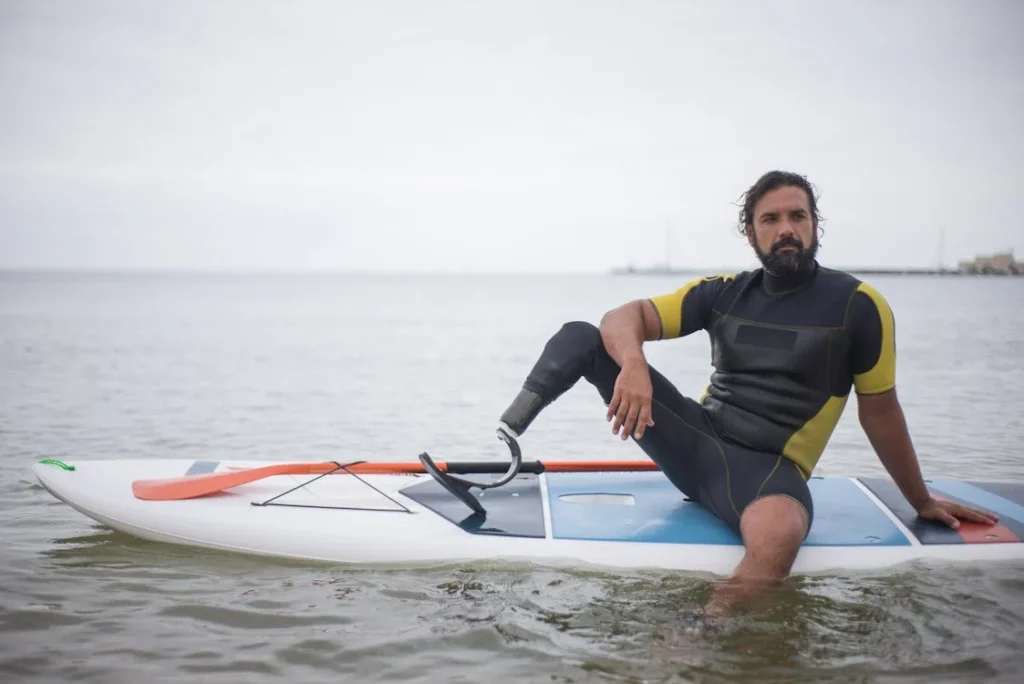
Step 4: Exploring the Option of a Temporary Prosthesis
Why Early Walking Isn’t Just About Speed
You may have heard of a “temporary” or “early fit” prosthesis. This is a lightweight version that helps people start walking sooner while their permanent prosthesis is being planned. For many, it’s a powerful stepping stone.
Temporary prosthetics are not designed for long-term use. They often need to be replaced as the limb changes shape. But they serve an incredibly important purpose: they help people stand, balance, and walk early on in a safe, supported way.
For some patients, this happens as soon as two to four weeks after surgery. Others may need six to eight weeks. Either way, the goal is gentle movement. Using a temporary prosthetic helps shape your limb, protect your joints, and prevent your body from weakening due to inactivity.
Emotionally, this stage is also a breakthrough. The first time someone stands again, even with a temporary limb, it often brings hope and motivation. It feels like forward movement—because it is.
Some hospitals and clinics refer to this as the IPOP or preparatory prosthesis phase. It’s monitored closely by your prosthetist and physiotherapist. They will watch how you move and make small changes as needed.
This is also the time when you’ll start learning how to take care of the prosthesis, how to clean your residual limb, and how to avoid common problems like skin irritation. The learning begins early and pays off for life.
Step 5: Evaluating Your Strength, Balance, and Mindset
Your Body Isn’t the Only Part That Needs to Be Ready
While your limb’s condition is crucial, it’s not the only thing that determines the right time for a prosthetic. Your overall strength, energy levels, and emotional readiness also play a big role.
After surgery, it’s normal to feel tired or weak. You may have lost weight. Your muscles may not be as strong as they used to be. Before you start walking with a prosthesis, you’ll need enough strength in your core, back, and remaining limbs to support yourself.
Physiotherapists work with you on basic exercises to build this foundation. Simple things like sitting up straight, transferring from bed to wheelchair, or balancing on one leg become training tools. They’re not just rehab—they’re preparation for walking again.
Balance is another key factor. A prosthetic changes your center of gravity. You need to learn how to shift your weight differently. Practicing these movements before the prosthesis is fitted helps reduce falls and injuries later.
Then there’s the emotional side. Some people are eager and ready. Others feel scared or unsure. Both are normal. What matters is that you feel informed and supported. A good rehab team will help you understand what’s coming and guide you at your own pace.
Only when your body and mind both say “yes” does the next step begin.
Step 6: Getting Your First Permanent Prosthetic
The True Beginning of a Lifelong Relationship
Once your limb has stabilized in shape, your wound is fully healed, and you’re strong enough to move safely, it’s time for your first permanent prosthesis. This isn’t a final destination, but it is a huge milestone.
Your prosthetist will take detailed measurements of your limb. They might use digital scans, molds, or a mix of both. Then, based on your walking style, weight, activity level, and goals, they will build a prosthetic that fits you specifically.
You’ll go through fitting appointments to make sure the socket feels snug but not painful. You’ll test out different components—feet, knees, or arms—to see what feels right. It’s a process of trial, feedback, and small adjustments.
This is also the time when your therapy becomes more advanced. You’ll practice walking on slopes, climbing stairs, or picking up objects. Every day you’ll get a little better, a little stronger. It won’t always be easy, but it will be rewarding.
At this stage, your prosthesis becomes part of your identity. Not because it defines you, but because you’ve worked with it, trained with it, and trusted it. You’ll develop routines around cleaning it, checking for wear, and managing your skin health.
And remember, this isn’t your “forever” prosthesis. Your limb may still change. Your life may evolve. Upgrades, replacements, and fine-tuning are part of the journey. But this first one? It’s the one that gets you back on your feet—literally.
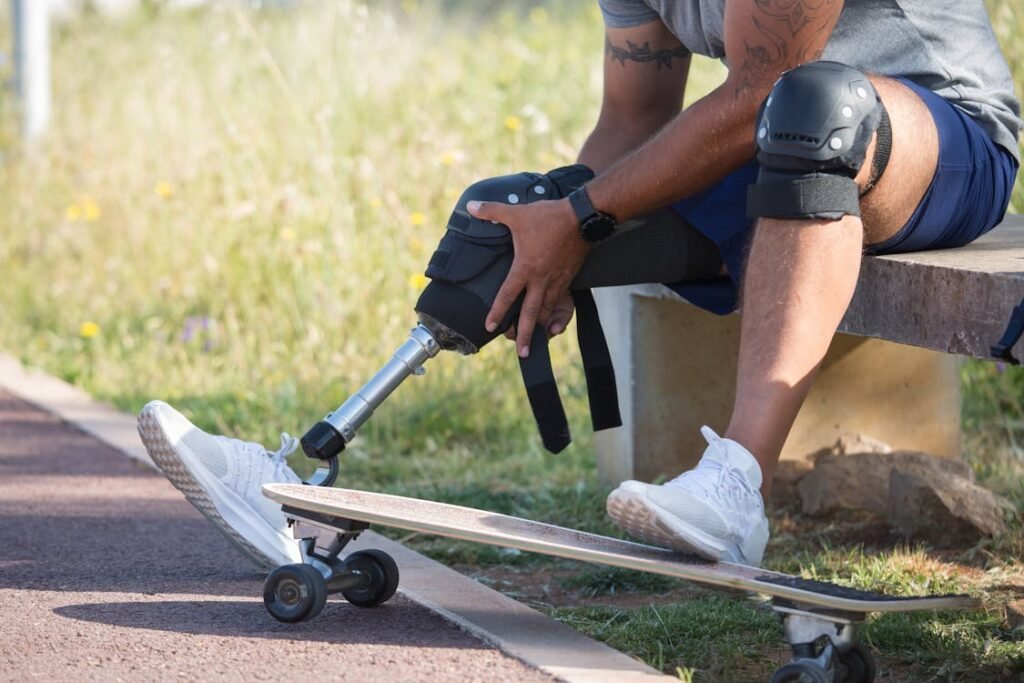
Step 7: Managing Expectations and Planning for the Long Term
The Road Ahead Is a Marathon, Not a Sprint
Even once you’ve received your prosthesis and taken those first steps, the journey is far from over. The timing of your first prosthetic is important, but equally important is how you live with it over time.
Some people adjust quickly. Others face setbacks. Your socket might need frequent adjustments. Your skin might become irritated. You might need extra therapy sessions. These are not signs of failure—they’re part of the process.
What helps the most is setting realistic expectations. You won’t be running a race in a week. But you will be moving. And over time, you’ll get faster, stronger, and more confident.
The more involved you are in your care, the better your outcome. Speak up if something feels wrong. Track your progress. Ask your prosthetist about upgrades. Explore support groups. Keep learning.
And don’t forget—your prosthesis is not just a tool. It’s a part of how you engage with the world again. Dance with it. Travel with it. Laugh, cry, and grow with it. That’s what it’s for.
Step 8: How Nutrition and General Health Impact Your Readiness
What You Eat Matters More Than You Think
Most people don’t realize how much their overall health affects prosthetic readiness. After surgery, your body enters a healing phase, and the food you eat becomes fuel for that healing.
If your nutrition is poor, wounds take longer to close. If your blood sugar is high, especially in diabetic patients, infections become more likely. This slows everything down—including when you can start with your prosthesis.
Your body needs protein to rebuild tissue. It needs vitamins like C and D for skin and bone health. It needs enough calories to fight inflammation and restore energy. Without these building blocks, even the best medical care can only go so far.
Hydration is just as important. Dehydrated tissue is slower to heal and more prone to damage. Drinking enough water helps circulation and skin elasticity—both of which play a key role in prosthetic use later on.
In some cases, your doctor may refer you to a nutritionist. This isn’t about dieting—it’s about giving your body what it needs to recover and prepare for the physical demands of prosthetic use. The better your internal condition, the faster your external progress.
This is especially true for older adults or people with other health issues. Healing doesn’t happen in isolation. It’s the result of many systems working together. Nutrition is one you can take charge of from day one.

Step 9: Recognizing the Risks of Waiting Too Long
When Delay Becomes a Barrier
While it’s important not to rush into prosthetic fitting too soon, delaying for too long can cause its own set of problems. And these problems don’t just affect your limb—they affect your entire life.
One of the first issues is muscle weakness. If you go too long without bearing weight or walking, your muscles begin to shrink. This is called atrophy, and it makes learning to walk later much harder. What should take weeks could take months.
Another risk is joint stiffness. Joints that aren’t moved regularly begin to lose range of motion. This is especially serious if your amputation is above the knee or elbow. Once stiffness sets in, regaining flexibility is difficult and often painful.
There’s also a psychological impact. The longer someone goes without walking, the more they adapt to a seated life. This may sound harmless, but it builds a comfort zone that can be hard to break. The prosthetic begins to feel optional instead of essential. That mindset can slow down progress dramatically.
Even from a social angle, waiting too long can make it harder to reintegrate. People may feel isolated, left behind, or out of rhythm with the world. They may hesitate to attend family events or go outside, even after they receive their prosthesis.
So while every body heals at its own pace, it’s important to keep moving toward that next step. Staying in the “waiting” phase for too long creates challenges that are avoidable with the right support and information.
Step 10: The Role of Family and Caregivers in Timing
You’re Not Alone—And That Changes Everything
Recovery is rarely a solo journey. For many people, the decision about when to start with a prosthetic is shaped not just by doctors, but by family and caregivers. And that’s a good thing—if managed well.
Caregivers often help with wound cleaning, transport, emotional support, and even financial planning. They see your progress daily. They know your highs and lows. Their insight is valuable, especially when you’re too tired or frustrated to think clearly.
But there’s a balance. Sometimes, well-meaning family members may urge you to “wait a little longer” because they’re afraid you’ll get hurt. Or they may push you too soon because they want life to feel normal again. Both reactions come from love—but both can be misaligned with what your body needs.
The best approach is open, honest communication. Tell your caregiver what you’re feeling physically and emotionally. Let them attend your appointments, if possible, so they understand what the doctors are saying. Invite them into the process instead of carrying it all yourself.
This partnership becomes even more important once you start walking. You’ll need encouragement. You’ll need a hand to hold when the steps feel scary. And sometimes, you’ll need someone to say, “You’ve got this,” when your own belief runs low.
Prosthetic success isn’t just about the device—it’s about the support system that surrounds it.
Step 11: Special Considerations for Children
Timing Is Different for Growing Bodies
When the patient is a child, everything changes. The question of when to get a first prosthetic becomes more complicated, because children are still growing—and growing fast.
In most cases, pediatric prosthetics are introduced early. Children’s bodies adapt quickly. Their bones and muscles respond well to movement. Plus, kids learn by doing. The earlier they’re introduced to a prosthetic, the more likely they are to treat it as a normal part of life.
However, children need more frequent replacements than adults. As they grow, the residual limb lengthens, the bone structure changes, and the socket that once fit perfectly begins to feel tight or awkward. That means regular checkups, ongoing adjustments, and sometimes full replacements every year or two.
Despite these challenges, early fitting is still the preferred route. It supports proper posture, balanced development, and early motor skills. More importantly, it prevents the emotional gap that can happen if a child spends too much time adapting without a limb.
Parents play a huge role in this process. From fitting sessions to therapy appointments to helping with social situations at school, their guidance makes a world of difference.
When done with care, pediatric prosthetic timing supports not just growth—but confidence, curiosity, and freedom to explore the world.

Step 12: Cultural Beliefs and Personal Readiness
Understanding What Readiness Really Means
In India and many other parts of the world, cultural beliefs around disability and prosthetics vary widely. Some families may see prosthetic use as a sign of strength and independence. Others may view it with fear, confusion, or even stigma.
These beliefs affect timing. A person might delay getting a prosthesis because they feel embarrassed. Or they may rush into it to prove something. Both are emotional responses—and both are common.
But prosthetic readiness is not about proving anything. It’s about your health, your goals, and your future.
If you’re feeling unsure because of what society might say, take a step back and look at your life. Ask yourself: What kind of daily routine do I want? What level of mobility makes me feel happy? Where do I see myself six months or a year from now?
These questions help you shift focus from what others think to what you need.
It also helps to speak with others who’ve walked this path. Peer groups, mentors, and online communities offer encouragement and clarity. You are not the first to feel uncertain. And you won’t be the last.
But when you act based on your truth—not fear or pressure—you reclaim control of your recovery.
Step 13: Budgeting, Insurance, and Financial Planning
Making Timing Work With Your Wallet
Let’s be honest: getting a prosthetic is an investment. Even with medical insurance, there are costs involved. This includes the device itself, fittings, therapy sessions, travel, and maintenance.
Many people delay getting a prosthetic simply because they believe they can’t afford it yet. But here’s what they often don’t realize: waiting can actually become more expensive in the long run.
Delays lead to longer hospital stays, extended use of wheelchairs or caregivers, more therapy hours, and sometimes more complications. All of this adds up. Getting mobile sooner can mean going back to work sooner. It can also mean fewer health issues down the line.
In India, there are government programs and NGOs that assist with prosthetic care. Some private hospitals offer installment payment options. Robobionics also works with patients to offer flexible, accessible solutions, especially for those who need early intervention but are financially stressed.
If you’re unsure about coverage, speak with your provider early. Ask detailed questions. Find out what’s covered, what isn’t, and what documentation is needed. Don’t wait until the last minute—financial planning should begin as soon as the healing starts.
A well-timed prosthesis isn’t just a health decision—it’s a financial one too. Plan early to walk sooner.
Step 14: The First 30, 60, and 90 Days With Your Prosthesis
What the Journey Looks Like Day by Day
So you’ve got your first prosthetic. What happens next?
In the first 30 days, everything feels new. You’ll spend time adjusting to the weight, the feel, the balance. You may walk short distances, with help. You’ll notice soreness, maybe frustration. This is normal.
By 60 days, you’ve likely had several adjustments to your socket. You’re walking more—maybe outside. You’ve developed routines for cleaning your limb, managing sweat, checking your skin. You’re also building endurance and trust.
At 90 days, you’re no longer thinking about every step. You’re focusing on goals. Can you climb stairs without help? Carry groceries? Visit your friend without planning every move? That’s the progress you’ll see.
This three-month window sets the stage for everything that follows. The better you manage these first 90 days, the smoother your long-term experience will be.
Celebrate small wins. Record your progress. Stay in touch with your prosthetist. This is your life—reclaimed one step at a time.
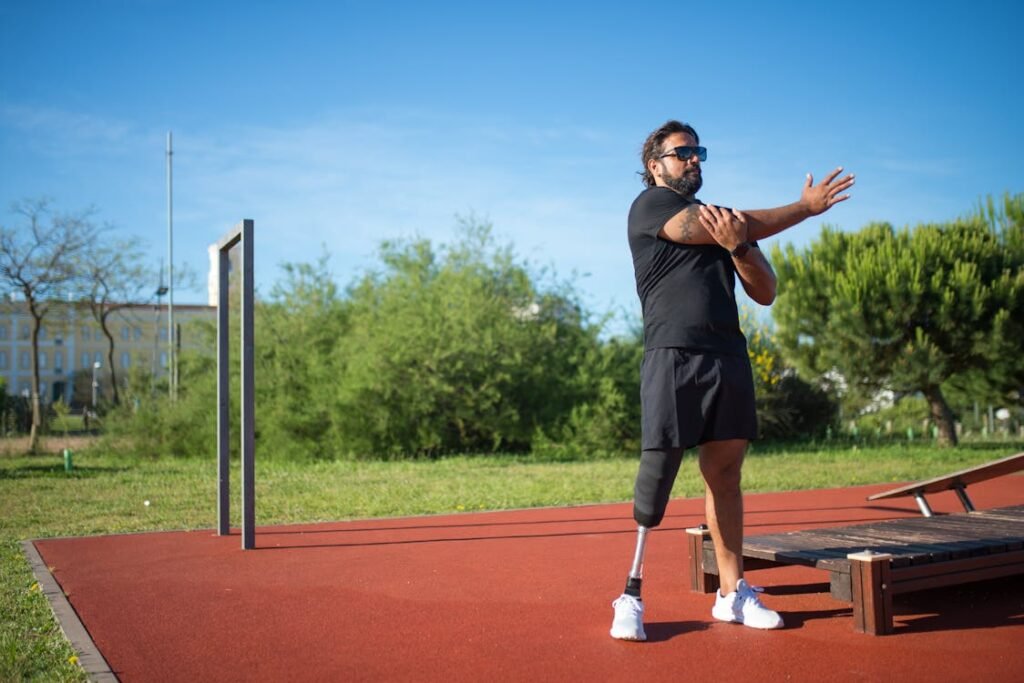
Conclusion
The real answer is this: you should get your first prosthetic when your body is ready, your mind is open, and your life is calling you to move forward. That could be three weeks after surgery. It could be three months. What matters is that you’re supported, informed, and surrounded by a team that listens to you—not just treats you.
Your first prosthetic is more than a device. It’s a gateway back to freedom, movement, and confidence. The timing matters—but even more important is that you keep moving toward that moment, step by step. At Robobionics, we’re here for you at every stage. From healing to fitting to lifelong support, we walk with you through every step of the journey. Because we don’t just build limbs—we help rebuild lives.



